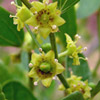Ziziphus lotus is a dense and very thorny shrub. Its fruits are edible. The leaf is dentate, ovate, glabrous. Contrary to a regular leaf, it has three parallel longitudinal midveins. The leaves are alternate. Sometimes, when they are arranged on a thin branch, they appear pinnate. The shrub is very thorny. The two stipules grow at the base of the leaf turn into hard thorns. One is straight and the other is hooked. The shrub is very dense. The branch is zigzagged. This combination of rigid hooked thorns together with dense growth turns it into an obstacle to pass through, especially when several shrubs grow together densely as a group (vegetative reproduction?).
Ziziphus lotus blooms in the spring, in March and April. The flowers are small, arranged in racemes. They are actinomorphic, bisexual, green-yellowish. They are not conspicuous from afar, but secrete large amounts of nectar and are visited by numerous insects, especially honeybees. The flower has 5 sepals, 5 petals, 5 stamens. The fruit is a fleshy round drupe. It has a large stone in the center, which is surrounded by a dry fleshy pulp. It has a diameter of 8-10 mm and a smooth pericarp. Upon ripening it turns light brown (as opposed to the color of Ziziphus spina-christi – Christ’s Thorn Jujube – which is yellow). The fruit is edible, not high quality, food for the poor. Some use it for making compote.
The plant is a poor relative of Ziziphus spina-christi – Christ’s Thorn Jujube. What are the differences? Christ’s Thorn Jujube sometimes reaches the dimensions of a distinguished tree, Ziziphus lotus is always a shrub. In general, everything about Ziziphus lotus is similar but smaller than in Christ’s Thorn Jujube, including the dimensions of the leaf and the fruit. Ziziphus lotus comes from the north, whereas Christ’s Thorn Jujube is of tropical origin and comes from the south. This may be why Ziziphus lotus sheds its leaves in the winter (usually not full exfoliation), whereas Christ’s Thorn Jujube remains green also in the winter (usually, not entirely consistently).
The Arabic name Sidar has become entrenched in the dialect of the inhabitants, and there is much said of efforts to clear out the “Sidars” in the history of the settlement in Israel. In the stories of the beginning of the Jewish settlement in the valleys in Israel, the “Sidaria” is known as a stubborn enemy, against whom the farmers fought. The name “Dom” stuck mainly to the fruit “Domim”. Some claim and use this name also for the fruit of Hawthorn (Ozrar – whose correct Arabic name is Za’arur). The fruit of Ziziphus lotus is of a lower quality and blander than the fruit of Christ’s Thorn Jujube. It is common on stony slopes and in alluvial soils in valleys, mainly in Batha-shrublands in all parts of northern Israel, from the Valley of Jezreel northwards.
Its global distribution spreads over the Mediterranean countries and East Africa.
The genus includes 100 species (others claim 40). In Israel there are 3 species, one is rare and two are very common.
Written by Mike Livne





